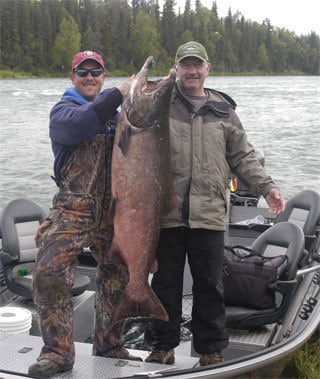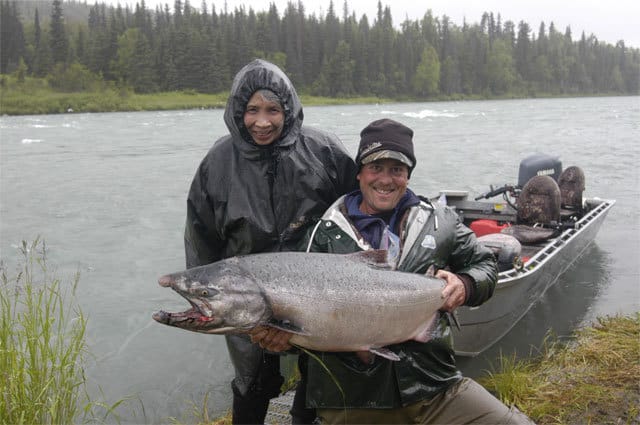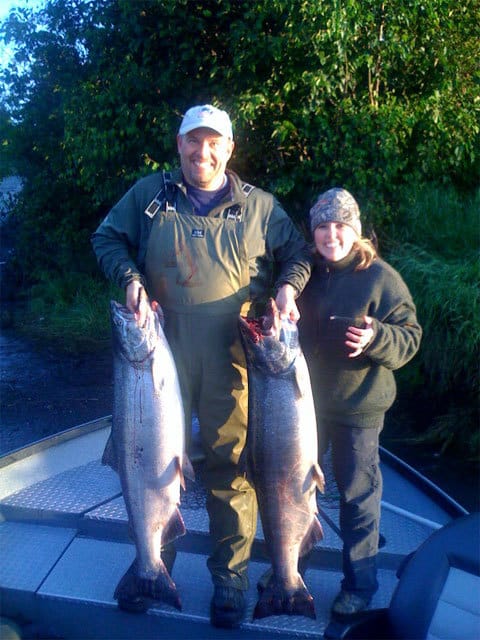
26 Jan The Worlds Best King Salmon Lure

The answer without question: Luhr Jensens’ Kwikfish!

For anyone that has fished the Kenai for king salmon, the name Kwikfish should definitely ring a bell. Many anglers who have landed seventy, eighty and even ninety pound king salmon will point to this magical lure as the key to their success. So what’s so special about these painted 3-5 inch banana shaped pieces of plastic? Good question. Whatever it is, they make king salmon go crazy. They elicit the most violent strike delivered by any Alaska game fish. I’ve seen fishing guides literally cry when they’ve lost their favorite Kwikfish and truth be told I’ve come pretty darn close to shedding a tear or two myself. These are really special lures. So why fret about losing a few if you can just buy more at the store? Its just not that simple, only 1 in 50 is truly “special.”
Finding that one “special lure” is no easy task. In the competitive world of professional guiding, every minute spent experimenting with unproven tackle is valuable time potentially wasted. Developing a solid line up of proven fish catching Kwikfish is hard enough to assemble and even harder to retain. Every trip is an adventure all it’s own and a million things can happen: both good and bad. I’ve gone weeks without even coming close to losing any “A-Team” lures and then at times they seem to just vaporize into the river. Last season, I lost my two favorite kwikfish to snags in the lower Kenai, BOTH on the last day of king season! The only silver lining to losing a few plugs to the river is the fact that it makes you develop new ones. There is always that hope that you discover the most lethal Kwikfish ever. It reminds me of the infamous Willy Wonka Chocolate Bars. Opening new Kwikfish is akin to finding that magical golden ticket: it’s the key to king salmon nirvana.
The history of Luhr Jensen Kwikfish is anchored in the Pacific Northwest and early salmon fishing on the West Coast. Veteran guides on storied rivers like the Sacramento and the Columbia quickly discovered the undeniable consistency Kwikfish seemed to have in making salmon strike. The banana shaped lure was actually created in Windsor Ontario Canada and likely enticed pike, walleye and Muskie before eventually migrating west. It was Pacific Northwest salmon fishing icons like Clancy Holt and Buzz Ramsey that innovated the Kwikfish and its remarkable evolution as a salmon killer. One game changing alteration to the lure was the addition of a sardine fillet to the belly. This turned a great lure into a legend in the salmon world. A well manicured slice of sardine flesh is affixed to the underside of a kwikfish using thread or rubber bands. The result is a visual and aromatic attraction that even the most finicky salmon cannot resist.
On the Kenai, Kwikfish are often used in conjunction with a Luhr Jensen jet diver, a plastic space shuttle looking device that when held upriver against the current, will dive deep and true; enabling the kwikfish to invade even the most deep and fast currents that the river holds.
While Kwikfish are very effective to fish, they are a lure that take great patience to fish and unless tuned properly these lures will just simply not work. Even the new pre-tuned Kwikfish X series often requires some degree of tinkering to yield desired results. On the Kenai, we are only allowed to use a single hook and the original Kwikfish is set up with two trebles. Removing the original and adding a single hook affects the balance of the lure and many just wont tune properly after the modification. A number simply wont run straight out of the box, regardless of how much tuning you employ.
I need not reach far into my memory bank to recount some very interesting Kwikfish stories from this past season alone:
My Mother and My Mother in Law

With my mom aboard in late June, I was especially on my toes so I noticed immediately as her rod tip twitched out of rhythm. Below us on the Kenai ‘s surface, a small trout simultaneously broke water. Another aggressive rainbow had attacked a Kwikfish nearly its same size. As I asked her to retrieve this non-target species for release, I again focused my attention on the three remaining rods all delivering their offerings to the prime part of the hole. I was fully expecting something to happen but I never expected what happened next. I first remember hearing the braided Tuf Line pouring off a reel. But where was it coming from? My mom had an eight inch trout on and all three remaining rods were in plain sight and had nothing. By then I could see my mom gripping the reel with added intensity and the rod bucked with power. I can only guess that while reeling her trout in, it came off, and then while retrieving the Kwikfish, an ocean bright 40lb king attacked it. In twenty years of guiding, that has never happened before.

With my Mother in Law (Nova) here for the entire month of July, I figured getting her out on the river to catch a king would be no problem. With our busy schedule and a relatively tough king season, time was winding down on my goal. In mid July, the stars aligned, or should I say the clouds. I was enjoying a rainy afternoon of sockeye fishing with my friend Dan and river conditions for the moment were ideal. Fish were rising throughout the river, both sockeye and king salmon, and there was just a fishy feeling to the day. With our limits of sockeye cleaned and in the fridge, we decided it was a perfect time to get Nova a king. To make sure they were biting, we tested a good hole just downriver from the lodge. Sure enough, we hooked two kings on two consecutive passes, both on Kwikfish. We lost one and quickly landed and released the other. We then raced back to the bank for Nova. She had her rain gear on in seconds and before we know it we are doing battle in a torrential rain storm with a true brute. Finally about 45 minutes later we were back at the house taking pictures with Nova’s 45lb (sorry Mom) hog. The fish crushed one of my favorite Kwikfish not more than 3 seconds after it hit the water.
On the double

Double hook ups for king salmon are not very common. Granted it does happen, but rarely does it occur while back trolling. This is because the first thing you do is get any other lines out of the water to avoid tangles. This day started with all the excitement and enthusiasm of any other July morning. More often than not, the first 30 minutes of the trip yields the majority of the action and the first pass is often the best pass of the day. I met Tom and his wife Kathy along with their good friend Keith at the launch just before six in the morning. I always look forward to fishing with Tom as he and his friend Keith are both accomplished hunters and I love hearing about their annual hunting adventures. As we settled into a select spot to begin the day, we all eyed our cell phones until mine read 6:00AM straight up. We put out all the lines perfectly and were all fishing in less than 30 seconds. In less than a minute, we were sideways with two ocean fresh forty pound king salmon tearing off line in opposite directions. As we bobbed and weaved through boulders and rough water, we managed to net both fish in the next mile of river. With two identical kings laying at our feet by 6:15AM, we all laughed like little kids. Recounting the rapid fire event, we hooked the first fish with the rod in the back holder. As it flattened out and I called out, “there ya go… reel em in!,” a second rod doubled over almost instantly. It all ended with an awesome husband-wife “double hook-up” that remains one of the most memorable starts of my entire guiding career.
